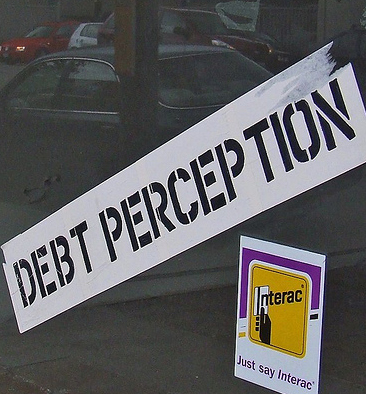What if the most common strategies to repay debt are wrong?

Two popular methods are used to repay debt. One focuses on the interest rate; the other focuses on “small wins.”
I recommend reading this post if you want a solid understanding of these two methods. Here’s the executive summary: the “Debt Stacking” method says you should repay the debt with the highest interest-rate first. The “Debt Snowball” method says you should repay the smallest debt first, regardless of its interest rate, so you can feel the psychological “win” of crossing it off your list.
I think both of these fall short. So today I’m going to propose a third method: the Forget Your Debt method.
The Status Quo Stinks
The Debt Stacking method makes logical sense. You’ll save the most money if you repay the loans with the highest interest rate.

The problem is that many people have a hard time motivating themselves to repay a large debt, regardless of its interest rate. No matter how much money they throw at a big debt, the balance never seems to subside. The person feels like they’re not making progress. It’s akin to being on a diet but never seeing the pounds melt away. They become discouraged and quit.
The Debt Snowball method, which obliterates the smallest debt first, can keep you motivated.
But it comes with a large price tag. You’ll make minimum payments on high-interest debt — which means the compounding balance will climb higher and higher.
For anyone who runs a spreadsheet to compare these two options, the hundreds — maybe thousands — of dollars it costs to use the Debt Snowball method is a bitter pill to swallow.
Switch Your Focus
The problem with both strategies is that they both focus on the wrong thing.
The interest-rate method focuses entirely on the numbers, but fails to take psychology and emotion into account. The Debt Snowball method focuses entirely on psychology and emotion, but fails to honor the numbers.
What if there was a method that focuses on both?
Forget Your Debt
Both the interest-rate method and the Debt Snowball method share one trait in common: they force you to think about your debt.
Thinking about debt stinks. It causes debtors to feel trapped, shackled. It breeds discouragement.
I want you to do the opposite: forget about your debt.
You’re Already Free
Debtor’s prisons were eliminated in the mid-19th century, but focusing on debt makes people feel imprisoned.

You’re no more “free” when you repay your debt than you were when you carried debt. (The other way of looking at it: you’re just as free with debt as you are without.)
You still have to put groceries on the table, keep the electricity on, fill your car with gas, put clothes on your back, save for retirement, send yourself or your kids to school, write checks to your insurance company and give the government your tax dollars. Fail to do even one of these things and you’re in serious trouble.
So why do people feel free when their last debt is repaid? It’s because they’ve spent too much time and energy focusing on debt. They should be concentrating on the bigger picture – and that starts with eliminating the “d” word.
Eliminate the D-Word
Repaying debt is like dieting. If you focus on deprivation, you’ll fail.
Tell yourself “I shouldn’t eat chocolate … and cupcakes … and warm brownies with a delicious scoop of French Vanilla ice cream on top … and I shouldn’t eat pizza with spicy pepperonis and ground sausage and fresh mozzarella … and a steaming bowl of chili with an ice-cold beer … and I shouldn’t have bacon, eggs and a buttermilk biscuit … ”

Neither your brain nor your stomach hears the “I shouldn’t.” If you think about the fact that you’re dieting, you’ll fail.
The trick to dieting is to focus not on the deprivation, but on the abundance. Instead of thinking about all the foods you shouldn’t eat, think about the foods you get to eat: blueberries, quinoa, fresh-caught salmon.
Diets don’t work. Embracing a healthy lifestyle does. Eat more of what’s good instead of less of what’s bad.
A successful diet requires eliminating the “D” word — “diet”.
Repaying debt is the same way. The fastest road to discouragement is to focus on debt and deprivation. You shouldn’t go to the movies. You shouldn’t go to dinner with your friends. You shouldn’t get a haircut.
What a terrible way to live.
Successfully getting out of debt also requires eliminating the “D” word. Shed your “debtor” identity.
Focus on more of whats good rather than less of what’s bad. You’re not trying to repay debt. You’re trying to build wealth.
Adopt a ‘Build Wealth’ Mindset
Adopting a wealth-building mentality can be tough if you’re used to thinking of yourself as a debtor. You have to switch from a mindset of sacrifice to a mindset of creating abundance. Here are a few pointers on how to do it:
#1: Eliminate the D-Word. Cross out all written references to that word. Announce to your significant other, your family and your friends that you’re not allowed to say the D-Word. Place a jar on your kitchen counter: every time you say the D-Word, you have to contribute a dollar to the jar.
#2: Read About Wealth-Building. Buy books, read magazines and blogs, and listen to podcasts that focus on building sustainable wealth. Be choosy. Stay away from media that focuses on cost-cutting as an act of deprivation. Focus on media that celebrates wealth-building as an exciting opportunity.
#3: Remember: You’re Already Free. Take a look at your bills each month. You have expenses just like everyone else: groceries, electricity, gas. Maybe a payment to your credit card is among your expenses, but guess what? Lots of debt-free people have expenses you don’t have, such as caring for an elderly parent or supporting 4 kids.
Getting out of debt won’t set you “free.” True financial freedom comes from having passive investments that make enough money to cover your cost of living. Most people don’t experience that, and those who do enjoy it have spent a decade or more relentlessly pursuing it.
#4: Get Excited About Opportunity. There is a wealth of opportunity (pun intended) to build your net worth. Pick your favorite methods: you can invest in real estate, buy dividend stock funds, start a business … the options are endless. Focus on the opportunities at your fingertips. Once you switch to this frame of thinking, you’ll notice a huge opportunity staring you in the face — the opportunity to save $100 a month or $200 a month in interest payments. This isn’t your get-out-of-debt plan; this is one of many opportunities in a grand wealth-building lifestyle. If you make a few extra payments on that MasterCard balance, you’re not “climbing out of debt;” you’re taking advantage a stellar opportunity.
#5: Make It Visual. Post photos of all the wealth-building opportunities you want to capitalize on. If you want to own rental properties, put up pictures of a building in a location you love. Want dividend stocks? Put up a graph of historic returns. Want to see how much an extra $100 a month towards your car loan will save you? Draw it, sketch it, graph it, and hang it on your walls.
#6: Write an Opportunity List and post it somewhere you see occasionally. If you post it somewhere you see everyday, you’ll grow numb to the sight of it; it will start to blend in with the background. You’re better off posting it somewhere you occasionally see, where it will catch you by surprise. Stick a copy in your sock drawer. Paste a copy to your glove compartment. Try outlandish: Tape it to the inside of your freezer, so you only see it when you open the freezer door.
Thanks to Jason Rogers, Gloria Payne (Morning Glory), Alan Cleaver and Mene Tekel for the photos.